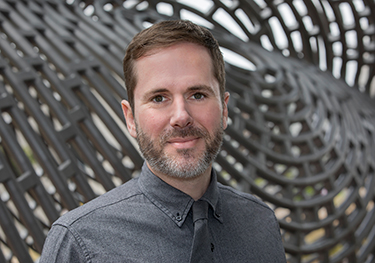Cedars-Sinai Blog
Expert in the Field: Cedars-Sinai's Artistic Eye
Apr 09, 2019 Cedars-Sinai Staff

Walk through Cedars-Sinai with John T. Lange, the medical center's art curator, and the hallways morph into a museum. The hospital's world-class collection of contemporary art is always on display, but when viewed from Lange’s perspective, the prints, paintings, sculptures and photos assume new layers of meaning.
Take, for example, Frank Stella's "Black Series," also known as the "Tuxedo Series." The small lithographs of geometric prints, made by Stella in 1967, hang in the executive hallway near the Marcia Simon Weisman Gallery. Step a few feet to the left, and there, embedded in a collage by David Hockney, is an element repurposed from the same Stella print series. Ask Lange, and he'll tell you that the placement is, of course, intentional—a nod to the fact that the artists were working in the same studio at the time of each work's conception, and that Hockney was known to reuse Stella's cast-offs.

John T. Lange, curator of the Cedars-Sinai collection.
"Making connections like that, it's one of the great things about this job," Lange says, and it's only one of many examples of the caring—both academic and therapeutic—that goes into his curation.
A Philadelphia native, Lange majored in sculpture at Tyler School of Art, Temple University. After graduation, he worked as a gallery assistant and shop technician for various galleries and studios in Philadelphia, Los Angeles and Rome, before joining URB Magazine in 2001 as a graphic designer and IT manager. It was in 2003 that Lange came across a job posting for a curator at Cedars-Sinai. Out of a crowd of candidates, Lange's eclectic résumé won him the post.
"They needed someone with an art history background to curate the collection, but also someone who could frame and hang the art in a museum style," he explains.
Lange, who is also a working artist, not only brings a deep affinity for the contemporary pieces that form the backbone of the medical center's collection, but also relishes the part that art plays in the healing process. Whether talking to donors, working with the medical center's Advisory Council for the Arts or installing artwork, his central goal is to create a therapeutic environment.
The medical center hallway in which he has installed a series of Old Hollywood photographs is an example: It's a favorite place for hospital staff to bring elderly patients, who often admire the images of the celebrities and are prompted to recognize their faces and speak their names.
At the end of the hallway, a mixed-media piece by Patrick Hogan, an artist who was incapacitated by a rare disease, offers a different sort of motivation. Hogan worked with twists of rope and fiber that, as the Los Angeles Times once noted, "… often floated off into a freedom of space his body could never imitate." Lange says the artist's life story serves as an inspiration for many of the patients who view his work.
"The way I see it, we're helping to create an environment that's at times soothing, and, at others, intentionally distracting or challenging, depending on the area," he says.
In the waiting rooms, the art is intended to give visiting family and friends something to think about; while in patient rooms and hallways, Lange seeks to create a calmer, more soothing experience. The medical center's employees are catered for too—in administrative and work areas, the art is selected for its potential to engage and stimulate.
"We can't lose sight of the fact that we're in a hospital—I'm adamant about that," Lange said, pointing out that the therapeutic purpose of the art is his top priority. "We do have museum-quality work here, but at the end of the day, this is a place of healing."
Read: Pictures of Health


